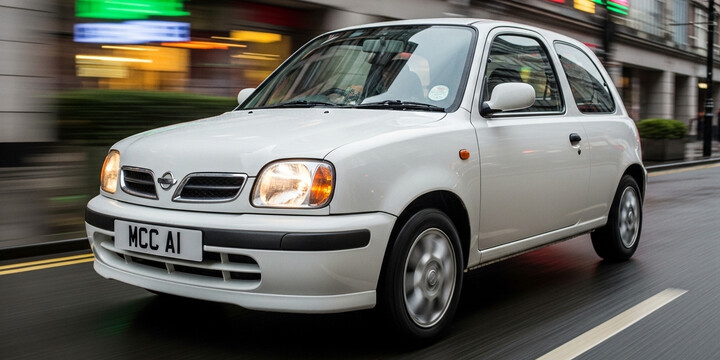
NISSAN MICRA (1995-03) 3DR HATCHBACK 1.0 SPORT
The NISSAN MICRA (1995-03) 3DR HATCHBACK 1.0 SPORT is a compact and practical city car that's ideal for navigating the busy streets of the UK. Known for its small size and nimble handling, this hatchback is perfect for first-time drivers, commuters, or anyone seeking an affordable and efficient vehicle for daily use. Its 1.0-litre engine offers excellent fuel economy, making it a cost-effective choice for those looking to keep running costs low. The Micra’s straightforward design and reliability have made it a popular choice among used car buyers, often serving as a dependable vehicle for many years.
What sets the Nissan Micra (1995-03) 3DR HATCHBACK 1.0 SPORT apart is its reputation for simplicity and affordability, with an average valuation of around £446 based on recent data. With an average mileage of roughly 78,106 miles and multiple previous owners, it’s a vehicle with a well-used but manageable history. While it may not have the flashiest features, this model is appreciated for its practicality, ease of driving, and iconic compact styling. Compared to its rivals, the Nissan Micra remains a reliable and accessible choice for those looking for an economical and straightforward city car that gets the job done.

average use

The data indicates that for the Nissan Micra (1995-03) 3-door hatchback 1.0 Sport model, the most common recent mileage readings are between 100,000 and 110,000 miles, accounting for 21.7% of recorded values. Notably, a significant proportion of vehicles—over 60%—have mileage readings at or above 80,000 miles, suggesting these cars tend to be high-mileage vehicles. Meanwhile, lower-mileage recordings under 20,000 miles make up less than 15%, indicating that most vehicles of this model and age are likely to have high mileage. This pattern could reflect the car's popularity for long-term use or resale trends among owners.

vehicle values

The available data indicates that for the Nissan Micra (1995-03) 3DR Hatchback 1.0 Sport, all private sale prices fall within the £0 to £1,000 range, representing 100% of the valuation spectrum. This suggests that vehicles of this model and age are consistently valued at the lower end of the price scale in private sales, reflecting their age, potential condition issues, or market demand for older models in the UK.

production years

The data indicates that the majority of Nissan Micra (1995-03) 3-door hatchbacks in this sample were manufactured in 2001, accounting for approximately 73.9%. Vehicles from 2000 make up about 21.7%, while a small percentage, 4.3%, were manufactured in 2002. This suggests that the earliest models are less prevalent in the dataset, with a significant concentration of vehicles produced around 2001, possibly reflecting production peaks or market trends during that period.

colour popularity

Based on the data for the Nissan Micra (1995-03) 3-door hatchback 1.0 Sport, the most common main paint colours are red (39.1%) and silver (34.8%), indicating these as popular choices among owners. Blue is also notable, accounting for 13% of the vehicles, while green and black are less common, representing 8.7% and 4.3% respectively. Overall, vibrant and neutral colours dominate, with red and silver being the predominant options.

ownership cycle

The data shows a varied distribution of registered keepers for the Nissan Micra (1995-03) 3-door hatchback 1.0 Sport model. Notably, the most common number of keepers is 7 and 2, each accounting for 17.4% of the vehicles in the sample. Vehicles with 5 and 6 keepers also represent a significant portion, each at 13%. Fewer vehicles have either very few or many keepers; for instance, only 4.3% have 9 or 12 keepers, while 8.7% have 3 or 8 keepers. This suggests a relatively moderate level of ownership changes, with a tendency towards vehicles having between 2 to 7 registered keepers.

engine choices

The data indicates that all Nissan Micra (1995-03) 3-door hatchback 1.0 Sport models in the sample have an engine capacity of 998cc, with 100% consistency. Additionally, the primary fuel type for these vehicles is petrol, which is also 100% across the sample. This suggests that within this specific model and period, there is a uniform engine size and fuel type, reflecting a standard configuration for this vehicle variant.












